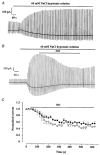Dual modulation of swelling-activated chloride current by NO and NO donors in rabbit portal vein myocytes
- PMID: 11018102
- PMCID: PMC2270118
- DOI: 10.1111/j.1469-7793.2000.00015.x
Dual modulation of swelling-activated chloride current by NO and NO donors in rabbit portal vein myocytes
Abstract
1. The effects of authentic NO and the NO donor S-nitroso-N-acetylpenicillamine (SNAP) on swelling-activated chloride currents (Iswell) were investigated in freshly dispersed rabbit portal vein smooth muscle cells. Iswell was recorded with the perforated patch configuration of the whole-cell patch clamp technique. 2. In approximately 50 % of cells NO and SNAP inhibited the amplitude of Iswell by about 45 % in a voltage-independent manner. Iswell was also inhibited by an inhibitor of NO-sensitive guanylate cyclase (1H-[1,2,4]oxadiazolo[4,3-a]quinoxalin-1-one (ODQ) and by KT5823, an inhibitor of cGMP-dependent protein kinase. 3. In other cells both NO and SNAP enhanced Iswell by about 40 % in a voltage-independent manner. A similar increase was produced by application of the cell-permeable cGMP analogue 8-bromo-guanosine 3', 5'-cyclic monophosphate (8-Br-cGMP). However, 8-Br-cGMP had no effect on current amplitude in cells pre-treated with KT5823. In contrast 8-Br-cGMP increased the amplitude of Iswell in cells which had been pre-treated with ODQ. 4. SNAP also modulated Iswell recorded in the conventional whole-cell configuration with internal solutions containing 10 mM EGTA to rule out any contribution from Ca2+-activated Cl- currents. 5. These data suggest that the amplitude of Iswell can be enhanced by NO via a cGMP-dependent phosphorylation and inhibited by NO in a cGMP-independent manner.
Figures






Comment in
-
NO and the regulation of VSOACs.J Physiol. 2000 Oct 1;528 Pt 1(Pt 1):2. doi: 10.1111/j.1469-7793.2000.t01-1-00002.x. J Physiol. 2000. PMID: 11018099 Free PMC article. No abstract available.
Similar articles
-
Calcium channel activation facilitated by nitric oxide in retinal ganglion cells.J Neurophysiol. 2000 Jan;83(1):198-206. doi: 10.1152/jn.2000.83.1.198. J Neurophysiol. 2000. PMID: 10634867
-
Cyclic GMP-dependent but G-kinase-independent inhibition of Ca2+-dependent Cl- currents by NO donors in cat tracheal smooth muscle.J Physiol. 1998 Sep 15;511 ( Pt 3)(Pt 3):719-31. doi: 10.1111/j.1469-7793.1998.719bg.x. J Physiol. 1998. PMID: 9714855 Free PMC article.
-
Nitrovasodilators relax mesenteric microvessels by cGMP-induced stimulation of Ca-activated K channels.Am J Physiol. 1997 Jul;273(1 Pt 2):H76-84. doi: 10.1152/ajpheart.1997.273.1.H76. Am J Physiol. 1997. PMID: 9249477
-
Nitric oxide donors enhanced Ca2+ currents and blocked noradrenaline-induced Ca2+ current inhibition in rat sympathetic neurons.J Physiol. 1995 Feb 1;482 ( Pt 3)(Pt 3):521-31. doi: 10.1113/jphysiol.1995.sp020537. J Physiol. 1995. PMID: 7738846 Free PMC article.
-
Inhibitory effect of nitrovasodilators and cyclic GMP on ET-1-activated Ca(2+)-permeable nonselective cation channel in rat aortic smooth muscle cells.Br J Pharmacol. 1997 Apr;120(8):1536-44. doi: 10.1038/sj.bjp.0701059. Br J Pharmacol. 1997. PMID: 9113376 Free PMC article.
Cited by
-
Modulation of volume-sensitive chloride current by noradrenaline in rabbit portal vein myocytes.J Physiol. 2002 Jul 15;542(Pt 2):537-47. doi: 10.1113/jphysiol.2002.018770. J Physiol. 2002. PMID: 12122151 Free PMC article.
-
Mechanisms of glutamate release from astrocytes.Neurochem Int. 2008 Jan;52(1-2):142-54. doi: 10.1016/j.neuint.2007.06.005. Epub 2007 Jun 26. Neurochem Int. 2008. PMID: 17669556 Free PMC article. Review.
-
Molecular mechanisms of regulation of fast-inactivating voltage-dependent transient outward K+ current in mouse heart by cell volume changes.J Physiol. 2005 Oct 15;568(Pt 2):423-43. doi: 10.1113/jphysiol.2005.091264. Epub 2005 Aug 4. J Physiol. 2005. PMID: 16081489 Free PMC article.
-
A cyclic GMP-dependent calcium-activated chloride current in smooth-muscle cells from rat mesenteric resistance arteries.J Gen Physiol. 2004 Feb;123(2):121-34. doi: 10.1085/jgp.200308972. Epub 2004 Jan 12. J Gen Physiol. 2004. PMID: 14718479 Free PMC article.
-
Activation of the cGMP/Protein Kinase G Pathway by Nitric Oxide Can Decrease TRPV1 Activity in Cultured Rat Dorsal Root Ganglion Neurons.Korean J Physiol Pharmacol. 2012 Jun;16(3):211-7. doi: 10.4196/kjpp.2012.16.3.211. Epub 2012 Jun 26. Korean J Physiol Pharmacol. 2012. PMID: 22802704 Free PMC article.
References
-
- Abderrahmane A, Salvail D, Dumoulin M, Garon J, Cadieux A, Rousseau E. Direct activation of a KCa channel in airway smooth muscle by nitric oxide: involvement of a nitrosylation mechanism? American Journal of Respiratory Cell and Molecular Biology. 1998;18:1–13. - PubMed
-
- Beckman JS, Koppenol WH. Nitric oxide, superoxide, and peroxynitrite: the good, the bad, and the ugly. American Journal of Physiology. 1996;271:C1424–1437. - PubMed
-
- Bolotina VM, Najibi S, Palacino JJ, Pagano PJ, Cohen RA. Nitric oxide directly activates calcium-dependent potassium channels in vascular smooth muscle. Nature. 1994;368:850–853. - PubMed
-
- Dick GM, Bradley KK, Horowitz B, Hume JR, Sanders KM. Functional and molecular identification of a novel chloride conductance in canine colonic smooth muscle. American Journal of Physiology. 1998;275:C940–950. - PubMed
-
- Du X-Y, Sorota S. Protein kinase C stimulates swelling-induced chloride current in canine atrial cells. Pflügers Archiv. 1999;437:227–234. - PubMed
Publication types
MeSH terms
Substances
Grants and funding
LinkOut - more resources
Full Text Sources
Miscellaneous

